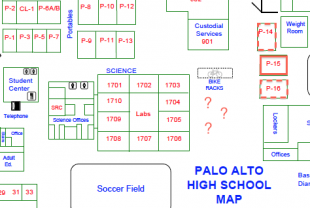
Facing ever-increasing numbers of students arriving at Palo Alto High School every year, the administration is looking to expand the science building by at least three classrooms, according to assistant principal Kim Diorio.
“We [the administration] have both a short term and a long term need,” Diorio said. “Short term, next year, we’re going to need additional chemistry rooms because the ninth graders taking biology now will be sophomores taking chemistry.”
The administration is considering converting two portables, P-14 and P-16, into chemistry classrooms, or possibly replacing them with new portables already configured as science rooms.
“One of the issues we’re running into this year, and it’s only gonna get worse over time, is we’re simply just running out of science classes,” Diorio said. “The science building currently has 10 classrooms, and it’s really impacting the master schedule and when we offer courses.”
But in the long term, the administration is facing a much larger problem.
“We’re looking at our enrollment projections, and we’re supposed to go up another two, three, 400 students in the next five years,” Diorio said. “And currently we’re feeling very maxed out on space.”
One of the portables between the gyms, P-15, was converted into a science classroom last year to address the rising need for more classrooms. But in future years, Diorio says at least an additional three classes are necessary, and the administration is looking toward a more permanent structure.
“Back in November, we discussed putting together a smaller subgroup … to explore potential spaces to increase or expand science classrooms on campus,” Diorio said. “The science planning committee has met twice now. Our architect drafted a few proposals and the committee has determined that the best solution would be to build on an addition to the current science building.”
A second story, which would have been most ideal, is unfortunately not possible, according to Diorio, because the building does not have the infrastructure and support necessary for such an expansion.
“Now we have to look at expanding onto one of the ends,” Diorio said.
A few different options will be drawn up and reported to the facilities steering committee in February. The administration is hoping to move on this quickly, completing the building itself within the next three years.
“This has really become a priority just because of our enrollment growth,” Diorio said. “Only 10 classrooms is really limiting. Ideally, 14 classrooms would meet our current needs and to do 15 or 16 would best meet our future needs.”
Other options were explored, such as expanding to the 700 building or the 900 building, but these solutions were not ideal from a logistical standpoint since the science supplies and labs are in the science building, according to Diorio. Spreading a department across campus would also hinder teacher collaboration and make it difficult to move supplies from one building to another.
Diorio added that the details of the expansion are still to be determined.
“We don’t know if these new classrooms will be chemistry classrooms or physics classrooms,” Diorio said. “We haven’t gotten into that level of detail yet, but there is definitely work being done now to increase our science classrooms.”

